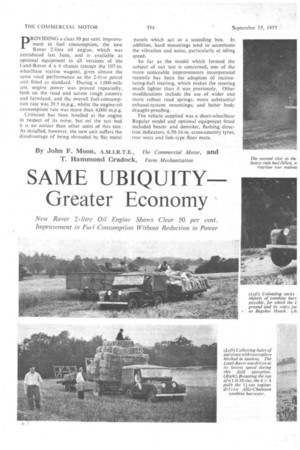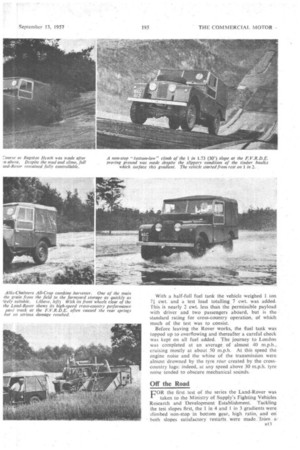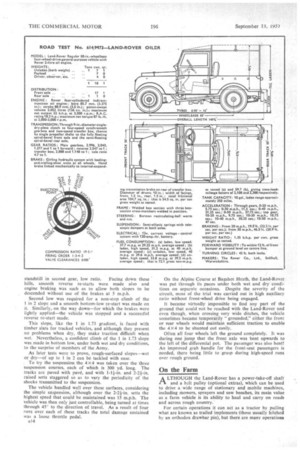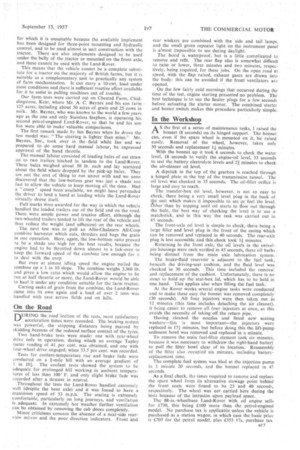SAME UBIQUITY
Page 46

Page 47

Page 48

Page 49

If you've noticed an error in this article please click here to report it so we can fix it.
Greater Economy
New Rover 2-litre Oil Engine Shows Clear 50 per cent. Improvement in Fuel Consumption Without Reduction in Power
pROVIDING a clear 50 per cent. improvement in fuel consumption, the new Rover 2-litre oil engine, which was intrciduced last June, and is available. as optional equipment in all versions of the Land-Rover 4 x 4 chassis (except the 107-in. wheelbase station wagon), gives almost the same road performance as the 2-litre petrol unit fitted as standard. During a 1,000-mile test, engine power was proved repeatedly, both on the road and across rough country and farmland, and the overall fuel-consumption rate was 29.5 m.p.g., whilst the engine-oil consumption rate was more than 4,000 m.p.g.
Criticism has been levelled at the engine in respect of its noise, but oil the test bed it is no noisier than other units of this size. As installed, however, the new unit suffers the disadvantage of being shrouded by flat metal panels which act as a sounding box. In addition, hard mountings tend to accentuate the vibration and noise, particularly at idling speed.
So far as the model which formed the subject of our test is concerned, one of the more noticeable improvements incorporated recently has been the adoption of recirculating-ball steering, which makes the steering much lighter than it was previously. Other modifications include the use of wider and more robust road springs; more substantial exhaust-system mountings; and better body draught-proofing.
The vehicle supplied was a short-wheelbase Regular model and optional equipment fitted included heater and demister, flashing direction indicators, 6.50-16-in, cross-country tyres, rear seats and link-type floor mats.
With a half-full fuel tank the vehicle weighed 1 ton 71 cwt. and a test load totalling 7 cwt. was added. This is nearly 2 cwt. less than the permissible payload with driver and two passengers aboard, but is the standard rating for cross-country operation, of which much of the test was to consist.
Before leaving the Rover works, the fuel tank was topped up to overflowing and thereafter a careful check was kept on all fuel added. The journey to London was completed at an average, of almost 40 m.p.h., cruising mostly at about 50 m.p.h. At this speed the engine noise and the whine of the transmission were almost drowned by the tyre roar created by the crosscountry lugs: indeed, at any speed above 30 m.p.h. tyre noise tended to obscure mechanical sounds.
Off the Road
pOR the first test of the series the Land-Rover was
taken to the Ministry of Supply's Fighting Vehicles Research arid Development Establishment. Tackling the test slopes first, the 1 in 4 and 1 in 3 gradients were climbed non-stop in bottom gear, high ratio, and on both slopes satisfactory restarts were made 'from a,
standstill in second gear, low ratio. Facing down these hills, smooth reverse re-starts were made also and engine braking was such as to allow both slopes to be descended without use of the brakes at 5 m.p.h.
Second low was required for a non-stop climb of the 1 in 2 slope and a smooth bottom-low re-start was made on it. Similarly, on the way down-for which the brakes were lightly applied-the vehicle was stopped arid a successful reverse re-start made.
This slope, like the 1 in 1.73 gradient, is faced with timber slats for tracked vehicles, and although they present no problems when dry, they make traction difficult when wet. Nevertheless, a confident climb of the 1 in 1.73 slope was made in bottom low, under both wet and dry conditions, to the surprise of members of the Army.
As later tests were to prove, rough-surfaced slopes-wet or dry-of up to I in 2 can be tackled with ease.
To try the suspension the 4X4 was taken over the three suspension courses, each of which is 300 yd. long. The tracks are paved with pave, and with 1-1i-in. and 2-21-in. raised setts staggered so as to vary the periodicity of the shocks transmitted to the suspension.
The vehicle handled well over these surfaces, considering the simple suspension, although over the 2-21-in. setts the highest speed that could be maintained was 15 m.p.h. The vehicle was then only just controllable, being turned at times through 45' to the direction of travel. As a result of four runs over each of these tracks the total damage sustained was a loose throttle pedal.
s14 On the Alpine Course at Bagshot Heath, the Land-Rover was put through its paces under both wet and dry conditions on separate occasions. Despite the severity of the circuit, most of the trial was carried out in high auxiliary ratio without front-wheel drive being engaged.
It became virtually impossible to find any part of the ground that could not be reached with the Land-Rover and even though, when crossing very wide ditches, the vehicle sometimes became temporarily grounded," either the front or rear wheels would maintain sufficient traction to enable the 4x4 to be shunted out easily,
Often all four wheels left the ground completely. It was during one jump that the front axle was bent upwards to the left of the differential pot. The passenger was also bent! An improved grab handle for the front-seat passengers is needed, there being little to grasp during high-speed runs over rough ground.
On the Farm
LTHOUGH the Land-Rover has a power-take-off shaft and a belt pulley (optional extras), which can be used to drive a wide range of stationary and mobile machines, including Mowers, sprayers and saw benches, its main value as a farm vehicle is its ability to haul and carry on roads and across rough country.
For certain operations it can act as a tractor by pulling what are known as trailed implements (those usually hitched by an orthodox drawbar pin), but there are many operations
for which it is unsuitable because the available implement has been designed for three-point mounting and hydraulic control, and to be used almost in unit construction with the tractor. There are also implements designed to be used under the belly of the tractor or mounted on the front axle, and these cannot be used with the Land-Rover.
This means that the vehicle cannot be a complete substitute for a tractor on the majority of British farms, but it is suitable as a complementary unit to practically any system of farm mechanization. It can carry a 10-cwt. load under most conditions and there is sufficient tractive effort available for it to assist in pulling machines out of trouble.
Our farm tests were carried out on Chested Farm, Chiddingstone, Kent, where Mr. A. C. Baynes and his son farm 125 acres, including about 50 acres of grain and 25 cows in milk. Mr. Baynes, who was known to the world a few years ago as the one and only Stainless Stephen, is operating his second petiol-engined Land-Rover, so that he and his son Ian were able to make valuable comparisons.
The first remark made by Ian Baynes when he drove the test model was: "The steering is lighter than mine." Mr. Baynes, Snr., took over in the field while Ian and we prepared to do some hard manual labour, he expressed approval of the hand throttle.
The manual labour consisted of loading bales of oat straw on to two trailers hitched in tandem to the Land-Rover. These bales weighed about 50 lb. each and lay scattered about the field where dropped by the pick-up baler. They are not the sort of thing to run about with and we soon discovered that the low-bottom gear was just a shade too fast to allow the vehicle to keep moving all the time. Had a "creep speed been available, we might have persuaded the driver to lend a hand at loading while the Land-Rover virtually drove itself.
Full marks Were awarded for the way in which the vehicle handled the loaded trailers out of the field and on the road. There were ample power and tractive effort, although the two-wheeled trailers tended to lift the rear of the vehicle and thus reduce the weight (and adhesion) on the rear wheels.
The next test was to pull an Allis-Chalmers All-Crop combine harvester which cuts, threshes and bags the grain in one operation. Here, again, the low-bottom ratio proved to be a shade too high for the best results, because the engine had to be throttled down almost to a tick-over to keep the forward speed of the combine low enough for it to deal with the crop.
But even at almost idling speed the engine pulled the combine up a 1 in 10 slope. The combine weighs 3,360 lb. and given a low ratio which would allow the engine to be run at half throttle or more, the Land-Rover would be able to haul it under any condition suitable for the farm tractor.
Carting sacks,of grain from the combine, the Land-Rover came into its own again and a load of over 2 tons was handled with ease across fields and on hills.
On the Road
nURING the road 'Section of the tests, most satisfactory
acceleration times were recorded. The braking system was powerful, the stopping distances being marred by skidding because of the reduced surface contact of the tyres.
Two hand-brake tests were made: one with rear-wheel drive only in operation, during which an average Tapley meter reading of 41 per cent, was obtained, and one with four-wheel drive engaged, when 535 per cent, was recorded.
Tests for coolant-temperature rise and brake fade were conducted on a I-mile hill with an average gradient of 1 in 10i.• The coolant tests showed the system to be adequate for prolonged hill working in ambient temperatures of less than 100' F. and only slight brake fade was recorded after a descent in neutral.
Throughout the tests the Land-Rover handled extremely well (despite the bent axle) and it was found to have a maximum speed of 53 m.p.h. The seating is extremely comfortable, particularly on long journeys, and ventilation is adequate. In extremely hot weather further ventilation can be obtained by removing the cab doors completely.
Minor criticisms concern the absence' of a near-side rearview mirror and the poor direction indicators. Front and rear winkers are combined with the side and tail lamps, and the small green repeater light On the instrument panel is almost impossible to see during daylight.
The hood is waterproof, but is a little complicated to remove and refit. The rear flap also is somewhat difficult to raise or lower, three minutes and two minutes, respectively, being required, for these jobs. On the open road at speed, with the flap raised, exhaust gases are drawn into the body: this can be avoided if the front ventilators are opened.
On the few fairly cold mornings that occurred during the time of the test, engine starting presented no problem. The best technique is to use the heater plugs for a few seconds before actuating the starter motor. The combined starter and heater switch makes this procedure particularly simple.
In the Workshop
As the first of a series of maintenance tasks, I raised the bonnet (8 seconds) on its hinged support. The bonnet can, even if the spare wheel is. mounted on it, be raised easily. Removal of the wheel, however, takes only 30 seconds and replacement Li minutes.
With the bonnet up it took 6 seconds to check the water level, 18 seconds to verify the engine-oil level, 33 seconds to test the battery electrolyte levels and 21 minutes to check the air-cleaner oil level.
A dipstick in the top of the gearbox is reached through a hinged plate in the top of the transmission tunnel. Theoil level was checked in 35 seconds. The oil-filler orifice is large and easy to reach.
The transfer-box oil level, however, is not so easy to check, there being a very small level plug in the back ot the unit which makes it impossible to sec or feel the level. Other than by topping until oil starts to flow out through the hole, the best way of checking the level is to use a matchstick, and in this way the task was carried out in 45 seconds.
The front-axle oil level is simple to check,there being a large filler and level plug in the front of the casing which can be removed and replaced in 40 seconds. The rear-axle plug is less accessible and this check took I; minutes.
Returning to the front axle, the oil levels in the swivelpin housings were each verified in 45 seconds, these oil baths being distinct from the main axle lubrication system. , The brake-fluid reservoir is adjacent to the fuel tank, beneath the driving-seat cushion, and the fluid level was checked in 30 seconds. This time included the removal and replacement of the cushion. Unfortunately, there is no strap to hold up the seat-box lid, which has to be held in one hand. This applies also when filling the fuel tank.
Al the Rover works several engine tasks were conducted and to make these easy the bonnet was removed completely (30 seconds). All four injectors were then taken out in 12 minutes (this time includes detaching the air cleaner), it being easier to remove all four injectors at once, as this avoids the necessity of taking off the return pipe.
Having cleaned the nozzles and fitted new seating washers—this is most important—the injectors were replaced in 171 minutes, but before doing this the lift-pump sediment bowl was removed and replaced in a minute. • To remove the main fuel-filter element took six minutes, because it was necessary to withdraw the right-hand battert. to pull the filter bowl clear of its location. Reassembly of the filter also occupied six minutes, including batteryreplacement time.
The complete fuel system was bled at the injection pump in I minute 20 seconds, and the bonnet replaced in 45 seconds.
As a final check, the times required to remove and replace the spare wheel from its alternative stowage point behind the front seats were found to be 23 and 40 seconds, respectively. The wheel was not carried here during the tests because of the intrusion upon payload space.
The 88-in.-wheelbase Land-Rover with oil engine sells for £730, this being £100 more than the petrol-engined model. No purchase tax is applicable unless the vehicle is purchased as a station wagon, in which case the basic price is £705 for the petrol model, plus £353 17s. purchase tax.




























































































